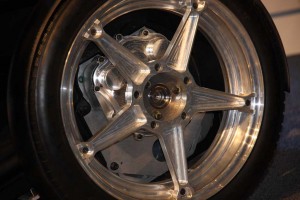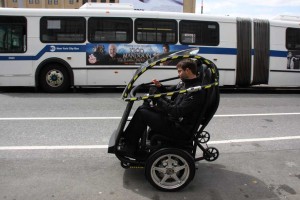
It would get 35 miles at 35 mph on 35 cents per charge, but is the GM-Segway PUMA more than a fanciful PR gimmick?
Larry Burns is “extraordinarily paranoid,” and he should be. The head of General Motors’ advanced research operations confides that he’s tracking at least 20 potential competitors who could revolutionize the automobile, much the way Apple’s iPhone did to home entertainment, and the PC did to big mainframe computers.
“Anyone betting on the status quo better think twice,” Burns told me following a news conference in New York City, Tuesday. That well-attended event allowed GM to lift the covers on its new PUMA – or Personal Urban Mobility and Accessibility vehicle – which it developed in cooperation with one of those 20 potentially disruptive players, Segway.
PUMA utilizes much of the basic technology behind Segway’s Personal Transporter, or PT, the little scooter you’ll see on college campuses and at airports around the country. The PT was initially hailed as a revolution, on its own, but its hefty, $5,400 pricetag, the fact that you have to stand up, and that there’s no shelter from the elements have all relegated the otherwise cutting-edge device to a low-volume niche. But working together, GM and Segway are aiming to demonstrate that the underlying technology could, in the words of Burns, “revolutionize urban transportation.”

PUMA uses many of the basic components from the Segway Personal Transporter, including a pair of wheel-mounted motors.
PUMA allows two passengers to sit, side-by-side, though there are, again, only two wheels, one on either side of you. A slick gyro system keeps the whole package stable, even sitting still at a stoplight. Using a PT-derived lithium-ion battery pack, the PUMA can achieve up to a 35 mph top speed and travel up to 35 miles on a charge, the electricity for which would cost you about 35 cents, according to Segway CEO Jim Norrod.
The entire package is about a sixth the size of the average vehicle you’d see on the streets of New York and only half the size of the already-miniscule urban transporter, the Smart fortwo. While no one is discussing hard numbers, the two partners suggest it would cost between one-third to one-quarter as much to buy and operate PUMA as a conventional automobile.
The version we saw, today, at the news conference was little more than a shell, looking like an unholy cross between an egg and a rickshaw. In fact, a production version would more likely appear to have rolled out of a science fiction movie. “I told my team that if it looks like a conventional automobile, they haven’t stretched far enough,” Dave Rand, GM’s director of advanced design, told me. A few examples displayed in an animation hinted of Star Wars, Bladerunner, even the Jetsons – though the production PUMA likely won’t be able to fold up into a briefcase.
As many of TheDetroitBureau.com readers know, I freelance for a wide variety of outlets and one of the most common questions my various editors are asking is how serious this project is? There’s no doubt that GM is hoping Project PUMA will help change its public persona – from that of a dying automaker that can’t cut the SUV umbilical to one of a resurgent manufacturer gearing up for the promised green paradigm shift.

Could a vehicle like the battery-powered PUMA find a place on city streets across the globe? It would certainly help solve gridlock, experts contend.
The truth is likely somewhere in-between. Certainly, GM needs all the positive PR it can get, and it got plenty of press coverage, from the Today Show to the New York Times, with PUMA. The fact that a company that normally has some of the slickest of concept cars opted to show little more than a shell is revealing. But the reality is that the high-tech two-seater is a clear hint of the imminent shift in the automotive landscape.
Contrary to conventional wisdom, light trucks are far from dead. In fact, since the sudden collapse in fuel prices, sales of pickups and SUVs have soared. Eventually, petroleum prices will rebound, and Americans will follow the trend set by buyers abroad. But there’s another, potentially more compelling factor.
As Burns pointed out, the vast majority of the globe’s population is shifting towards cities like Singapore, Beijing, London and New York. Those cities are approaching a permanent case of gridlock, as I was reminded during a half-hour, 2.5-mile taxi ride to the GM/Segway event.
“This is exactly what the auto industry needs, at this point,” said Prof. Bill Mitchell, of MIT’s Smart Cities program, following the PUMA unveiling. “Incremental changes and restructuring of the traditional business model – and the traditional automobile – won’t work. Fundamental change is what’s needed if we’re serious about building the economy along a clean, green basis.”
The fact that PUMA is small and extremely efficient is but part of the appeal. “Today’s car isn’t even as smart as the horse and carriage,” suggested Prof. Mitchell. PUMA, on the other hand, would be connected to a citywide network that connects each vehicle, almost like “a mobile Facebook,” added GM’s Burns.
That would, first of all, give each vehicle a bit of “smarts,” helping a PUMA sidestep a traffic jam or other obstacle, and even find parking and a charging station. You could keep in touch with friends, and access all the information now accessible from your desktop computer. And, eventually, such vehicles could become autonomous, the long-sought goal of urban planners and science fiction authors.
Technology certainly has its appeal, as does fuel efficiency and environmental friendliness, but just as Apple realized with its various iPods and iPhones, “You can’t get people to accept a vehicle solely on the basis of saving the planet,” said Prof. Mitchell. “It also has to be fun and fashionable.”
Is the PUMA just another one of those cool auto show concept vehicles that comes and goes, never to have any real impact on automotive reality? That remains to be seen, but we Segway CEO Norrod insists he’s in active conversation with a number of far-thinking governments, around the world. There’s strong interest from a list of cities including Paris, Beijing, Shanghai and Singapore. Sadly, there’s been little more than lip service from U.S. cities, like NY, he reports.
Meanwhile, we should see at least one fully-clad prototype emerge from Dave Rand’s studio later this year.
